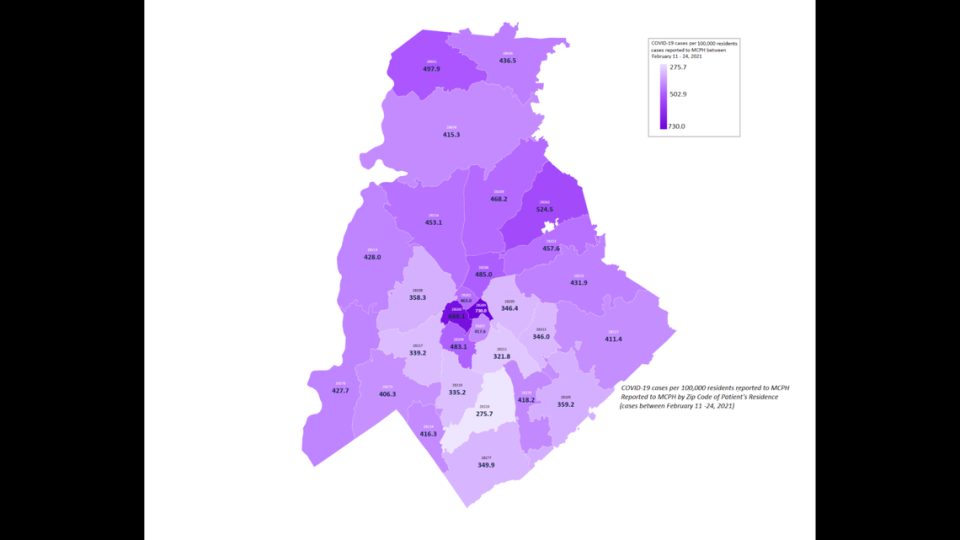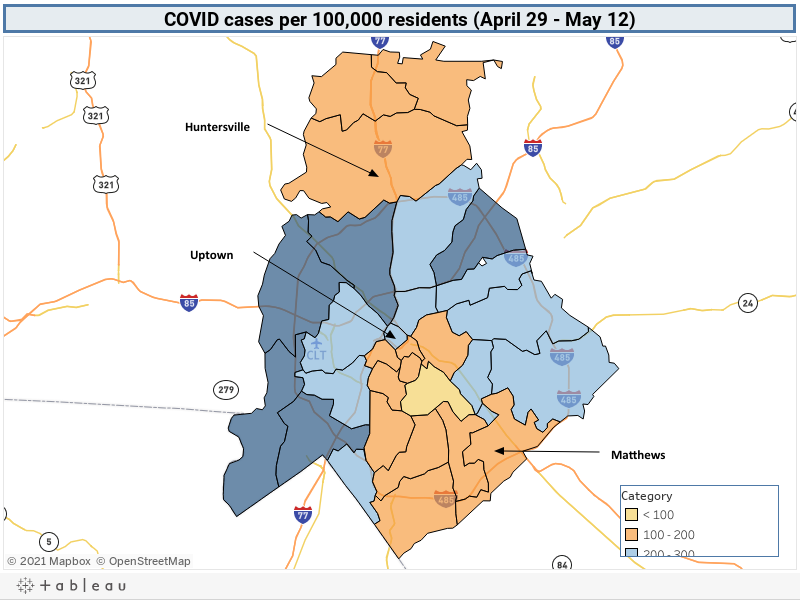Map of COVID case rates in Charlotte: These four ZIP codes saw an increase.
Four Mecklenburg ZIP codes saw an increase in COVID-19 case rates over the past week, ending the county’s run through most of February of decreased numbers in every ZIP code.
However, the spread of coronavirus cases is still slowing locally, and the most recent data shows every ZIP code in and around Charlotte with fewer than 800 new cases per 100,000 residents.
It’s a slow but steady improvement from the uptick during the holidays.
The COVID case rate data by ZIP code — which Mecklenburg County Public Health releases at least twice per month — shows only the most recent, or active, infections detected by coronavirus testing, and takes into account population to show where cases are most concentrated. The most recent data overlaps one week with the previous data release.
Based on positive coronavirus test results from Feb. 11-24, the countywide 14-day average case rate was 392.7 new cases per 100,000 residents — the lowest rate in Mecklenburg since late November, when public health officials began releasing ZIP code-level information.
The county’s highest concentration of infections over the two-week period ending Feb. 24 is near uptown Charlotte and parts of University City.
Neighborhoods in Cherry and Elizabeth had the highest case rate in Mecklenburg County, by a significant amount, in the second half of February. The 28204 ZIP code saw the highest jump in case rate compared to last week, followed by 28036 (northern Mecklenburg County, near Davidson); 28277 (on the South Carolina border, includes Ballantyne and some neighborhoods along Rea Road); and 28207 (near Queens University, includes Eastover and neighborhoods around Providence Road).
Previous data showed the highest number of cases in South End and parts of Dilworth but ZIP code 28203 saw a significant decrease last week. It remains, though, the second-highest ZIP code by current case rate.
The Steele Creek and Lake Wylie area near the South Carolina border saw the biggest fall last week in case rate, dropping by a concentration of more than 200 cases, compared to early-to-mid-February.
Previous data showed all but six ZIP codes with case rates below 600. The most recent data covering the past two weeks shows all but two ZIP codes with case rates below 600.
As Charlotte and North Carolina’s case rates stabilize, Gov. Roy Cooper announced Wednesday that bars are allowed to serve patrons indoors again, and a more stringent local health directive as expired.
What’s open? Bars and restaurants announce changes as some COVID restrictions lifted.
How to get on a Mecklenburg vaccine wait list, and other COVID tips we learned this week
COVID-19 case rates by zip code
This data comes from Mecklenburg County Public Health and includes positive COVID-19 test results, based on a person’s home ZIP code, between Feb. 11 and Feb. 24.
Below 400 cases per 100,000 residents
28226: 275.7
28211: 321.8
28210: 335.2
28217: 339.2
28212: 346.0
28205: 346.4
28277: 349.9
28208: 358.3
28105: 359.2
Between 400-450 cases per 100,000
28273: 406.3
28227: 411.4
28078: 415.3
28134: 416.3
28207: 417.6
28270: 418.2
28278: 427.7
28214: 428.0
28215: 431.9
28036: 436.5
Between 450-500 cases per 100,000
28216: 453.1
28213: 457.6
28202: 463.0
28269: 468.2
28209: 483.1
28206: 485.0
28031: 497.9
Above 500 cases per 100,000
28262: 524.5
28203: 688.1
28204: 730.0
Gavin Off contributed to this report.


